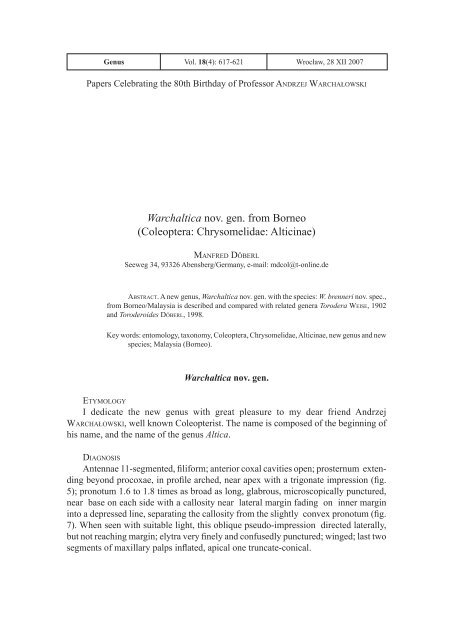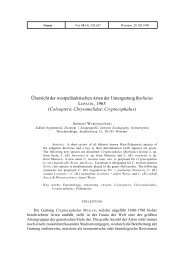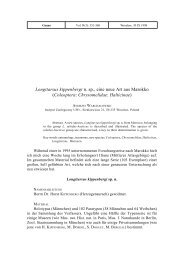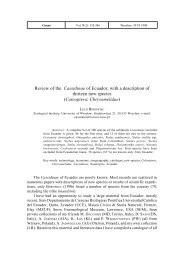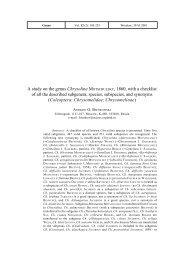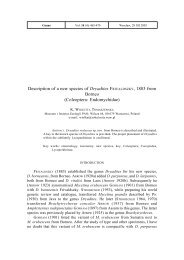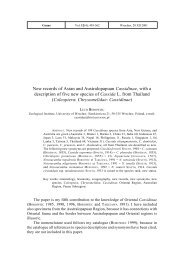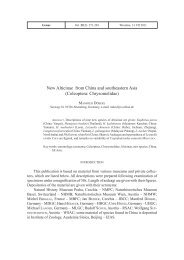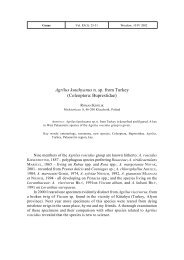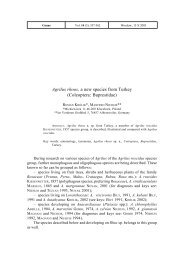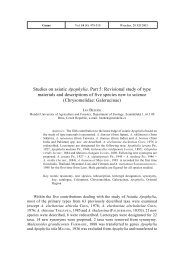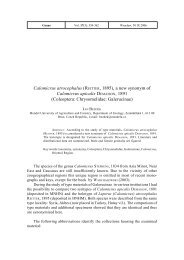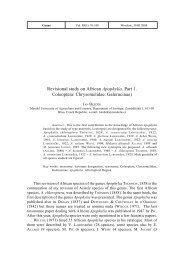Warchaltica nov. gen. from Borneo (Coleoptera: Chrysomelidae ...
Warchaltica nov. gen. from Borneo (Coleoptera: Chrysomelidae ...
Warchaltica nov. gen. from Borneo (Coleoptera: Chrysomelidae ...
You also want an ePaper? Increase the reach of your titles
YUMPU automatically turns print PDFs into web optimized ePapers that Google loves.
Genus Vol. 18(4): 617-621 Wrocław, 28 XII 2007<br />
Papers Celebrating the 80th Birthday of Professor Andrzej Warchałowski<br />
<strong>Warchaltica</strong> <strong>nov</strong>. <strong>gen</strong>. <strong>from</strong> <strong>Borneo</strong><br />
(<strong>Coleoptera</strong>: <strong>Chrysomelidae</strong>: Alticinae)<br />
Manfred Döberl<br />
Seeweg 34, 93326 Abensberg/Germany, e-mail: mdcol@t-online.de<br />
Abstract. A new <strong>gen</strong>us, <strong>Warchaltica</strong> <strong>nov</strong>. <strong>gen</strong>. with the species: W. brenneri <strong>nov</strong>. spec.,<br />
<strong>from</strong> <strong>Borneo</strong>/Malaysia is described and compared with related <strong>gen</strong>era Torodera Weise, 1902<br />
and Toroderoides Döberl, 1998.<br />
Key words: entomology, taxonomy, <strong>Coleoptera</strong>, <strong>Chrysomelidae</strong>, Alticinae, new <strong>gen</strong>us and new<br />
species; Malaysia (<strong>Borneo</strong>).<br />
<strong>Warchaltica</strong> <strong>nov</strong>. <strong>gen</strong>.<br />
Etymology<br />
I dedicate the new <strong>gen</strong>us with great pleasure to my dear friend Andrzej<br />
Warchałowski, well known Coleopterist. The name is composed of the beginning of<br />
his name, and the name of the <strong>gen</strong>us Altica.<br />
Diagnosis<br />
Antennae 11-segmented, filiform; anterior coxal cavities open; prosternum extending<br />
beyond procoxae, in profile arched, near apex with a trigonate impression (fig.<br />
5); pronotum 1.6 to 1.8 times as broad as long, glabrous, microscopically punctured,<br />
near base on each side with a callosity near lateral margin fading on inner margin<br />
into a depressed line, separating the callosity <strong>from</strong> the slightly convex pronotum (fig.<br />
7). When seen with suitable light, this oblique pseudo-impression directed laterally,<br />
but not reaching margin; elytra very finely and confusedly punctured; winged; last two<br />
segments of maxillary palps inflated, apical one truncate-conical.
618 manfred Döberl<br />
Description<br />
Antennal calli smooth, ± trigonate, separated <strong>from</strong> vertex by a deeply impressed<br />
transverse impression (fig. 2); basal and at least ultimate segments of antennae lightcoloured.<br />
Elytra longish-oval; basally not broader than base of pronotum; humeral<br />
calli small; disk very finely, densely and confusedly punctured. Hind tibiae rounded<br />
on dorsum; inner edge apically produced, outer end obtusely edged, with a short spine<br />
inserted near the outer side, tarsi inserted at the outermost end of tibiae, third segment<br />
bilobed, first segment of hind tarsus shorter than the following two combined; claw<br />
segment of hind tarsi not inflated, claws appendiculate. Sexual differences: ♂♂ first<br />
article of anterior tarsi distinctly arched laterally; ♀♀ nearly straight laterally. Type<br />
species: <strong>Warchaltica</strong> brenneri <strong>nov</strong>. sp.<br />
1. <strong>Warchaltica</strong> brenneri n. sp.: habitus<br />
Remarks<br />
There are some other specimens of this new <strong>gen</strong>us at my disposal, all with the<br />
dorsum reddish-yellow with a black pattern on the elytra, but unfortunately only singletons;<br />
therefore, I decided to wait for additional material before describing them.<br />
Discussion<br />
There exist already two other <strong>gen</strong>era with oblique pseudo-impressions on the<br />
pronotum: Torodera Weise, 1902 and Toroderoides Döberl, 1998. They share with<br />
<strong>Warchaltica</strong> the following characters: anterior coxal cavities open, prosternum extending<br />
beyond the procoxae; pronotum basally not broader than base of pronotum;<br />
elytra very finely and confusedly punctured; tarsi with third segment bilobed; claws<br />
appendiculate.
warchaltica <strong>gen</strong>. et sp. <strong>nov</strong>.<br />
619<br />
The three <strong>gen</strong>era can be separated as follows:<br />
1 (2) Form round, hemisphaerical; antennal calli not sharply bordered (fig. 4), first<br />
segment of hind tarsus only slightly longer than the following two combined<br />
................................................................................................… Torodera Weise<br />
2 (1) Form elongate oval, antennal calli anteriorly distinctly bordered (figs. 2, 3)<br />
3 (4) Prosternum near apex with a trigonate impression (fig. 5). First segment of hind<br />
tarsus shorter than the following two combined ........… <strong>Warchaltica</strong> <strong>nov</strong>. <strong>gen</strong>.<br />
4 (3) Prosternum near apex with a mid keel (fig. 6). First segment of hind tarsus longer<br />
than the following two combined …................................. Toroderoides Döberl<br />
<strong>Warchaltica</strong> brenneri <strong>nov</strong>. spec.<br />
(figs. 1, 2, 5, 7, 8, 9, 10)<br />
Etymology<br />
Named after the collector Uli Brenner, who kindly gave me the opportunity to<br />
study his material <strong>from</strong> <strong>Borneo</strong>.<br />
2, 5, 7, 8-10. <strong>Warchaltica</strong> brenneri n. sp.: 2 – head, 5 – prosternum (p= profil), 7 – pronotum, 8-10 – aedoeagus:<br />
8 – dorsal, 9 – ventral, 10 – profil; 3. Toroderoides quadrimaculata, head; 4. Torodera septempunctata,<br />
head; 6. Toroderoides wiesneri, prosternum
620 manfred Döberl<br />
Description (magnification at 50x)<br />
Measurements of Holotype (♂): Length = 6.6 mm, Width = 3.9 mm. Head, pronotum,<br />
scutellum and legs yellowish-brown; elytra including epipleurae black, each<br />
eytron with two yellow patches, one in basal third, the other near apex and extending<br />
to apical margin. Antennae with segments 1-3 and 10-11 yellowish-brown, 4 going<br />
darker, 5-9 blackish, clearly in contrast to others ; pro- and mesothorax yellowish-brown;<br />
remaining parts piceous; legs yellowish with tibiae and tarsi darkened. Head smooth,<br />
frons 0.66 times as broad as the distance between lateral ocular borders . Antennal calli<br />
trigonate, well developed, limited behind by a deep impression, their ends extending<br />
to interantennal space, separated by short sulcus and by dorsal end of frontal ridge;<br />
broadened anteriorly to clypeus; its lateral margins with elongate rugosities. Proportions<br />
of antennal segments in holotype are 21:9:16:21:24:21:20:17:18:17:21 (1 = 0.01<br />
mm). Pronotum 1.66 times as broad as long; subquadrate; smooth, microscopically<br />
punctured; posterior margin slightly arched, somewhat produced in middle; sides<br />
weakly margined; each corner provided with a setiferous angle ; posterior corners<br />
± rectangular, but not sharp; anterior corners broadly obliquely truncate. Scutellum<br />
trigonate, smooth. Elytra elongate-oval; basally not broader than base of pronotum;<br />
humeral calli small; disk very finely, densely and confusedly punctate, punctures<br />
more distinctly seen on yellow patches. Underside and legs: Prosternum distinctly<br />
extending beyond anterior coxae, near the apex with a deep impression. Hind tibiae<br />
with a short spine inserted near outer side; inner edge apically produced; outer end<br />
obtusely edged; tarsi inserted at outermost end of tibiae; third segment bilobed, claws<br />
appendiculate. Epipleurae smooth, ± horizontal, extending nearly to apex. Sexual<br />
differences: ♂ first article of anterior tarsi lateral margins distinctly arched; Aedeagus<br />
(length = 2.0 mm) (figs. 8-10); ♀ unknown.<br />
Type material<br />
Holotype (♂) Malaysia, <strong>Borneo</strong>, Sabah p. Ranau, Mount Kinabalu, 1500 m, 3. III.<br />
1998 leg. Brenner (coll. auct.); paratypes: 4♂♂ dito (1 coll. auct., 2 Museum Senckenberg/Frankfurt<br />
a.M., 1 coll. Warchalowski); 1♂ <strong>Borneo</strong>, Sabah W. Mount Kinabalu S.,<br />
28. V. 1999, leg. Smrž (coll. auct.)<br />
Distribution<br />
Malaysia (<strong>Borneo</strong>: Mt. Kinabalu).<br />
Acknowledgements<br />
I wish to express my heartfelt thanks to Mr Uli Brenner, Schlüchtern/Germany,<br />
who kindly gave me the holotype of <strong>Warchaltica</strong> brenneri for my collection. I’m also<br />
thankful to Mrs. Marianne Müller, Zool. Staatssammlung Munich for the excellent<br />
photograph.
warchaltica <strong>gen</strong>. et sp. <strong>nov</strong>.<br />
621<br />
References<br />
Döberl, M., 1998. Beitrag zur Kenntnis der Alticinen der Orientalischen Region (<strong>Coleoptera</strong>, <strong>Chrysomelidae</strong>,<br />
Alticinae). Entomol. Blätt., 93(1997): 135-142.<br />
Jacoby, M., 1906. Descriptions of new <strong>gen</strong>era and species of African Halticinae and Galerucinae. Trans.<br />
Entomol. Soc. London, 1906: 11-52, pl. 3.<br />
Scherer, G., 1987. The Genus Torodera Weise (<strong>Coleoptera</strong> – <strong>Chrysomelidae</strong> – Alticinae). Entomol. Arb.<br />
Mus. Frey, 35/36: 67-71.<br />
Weise, J., 1902. Afrikanische Chrysomeliden. Archiv f. Naturgesch., 68(1): 119-174.


